Low-Frequency Low-Reflection Bidirectional Sound Insulation Tunnel with Ultrathin Lossy Metasurfaces
Abstract
:1. Introduction
2. Design and Performance of Unit Cells and AMs
3. Design and Performance of Low-Frequency Low-Reflection BSI Tunnels
4. Mechanisms of Low-Frequency Low-Reflection BSI
5. Experimental Verification
6. Application of Tunnel in Open Window with Low-Frequency Low-Reflection BSI
7. Conclusions
Author Contributions
Funding
Institutional Review Board Statement
Informed Consent Statement
Data Availability Statement
Conflicts of Interest
References
- Zarek, J.H.B. Sound absorption in flexible porous materials. J. Sound Vib. 1978, 61, 205–234. [Google Scholar] [CrossRef]
- Arenas, J.P.; Crocker, M.J. Recent trends in porous sound-absorbing materials. Sound Vib. 2010, 44, 12–17. [Google Scholar]
- Toyoda, M.; Sakagami, K.; Takahashi, D.; Morimoto, M. Effect of a honeycomb on the sound absorption characteristics of panel-type absorbers. Appl. Acoust. 2011, 72, 943–948. [Google Scholar] [CrossRef] [Green Version]
- Liu, Z.Y.; Zhang, X.X.; Mao, Y.W.; Zhu, Y.Y.; Yang, Z.Y.; Chan, C.T.; Sheng, P. Locally resonant sonic materials. Science 2000, 289, 1734–1736. [Google Scholar] [CrossRef]
- Fang, N.; Xi, D.J.; Xu, J.Y.; Ambati, M.; Srituravanich, W.; Sun, C.; Zhang, X. Ultrasonic metamaterials with negative modulus. Nat. Mater. 2006, 5, 452–456. [Google Scholar] [CrossRef]
- Li, J.; Fok, L.; Yin, X.B.; Bartal, G.; Zhang, X. Experimental demonstration of an acoustic magnifying hyperlens. Nat. Mater. 2009, 8, 931–934. [Google Scholar] [CrossRef]
- Christensen, J.; de Abajo, F.J.G. Anisotropic metamaterials for full control of acoustic waves. Phys. Rev. Lett. 2012, 108, 124301. [Google Scholar] [CrossRef]
- Liang, Z.X.; Li, J.S. Extreme acoustic metamaterial by coiling up space. Phys. Rev. Lett. 2012, 108, 114301. [Google Scholar] [CrossRef]
- Cummer, S.A.; Christensen, J.; Alu, A. Controlling sound with acoustic metamaterials. Nat. Rev. Mater. 2016, 1, 16001. [Google Scholar] [CrossRef] [Green Version]
- Tsang, L.; Liao, T.H.; Tan, S.R. Calculations of Bands and Band Field Solutions in Topological Acoustics Using the Broadband Green’s Function-KKR-Multiple Scattering Method. Prog. Electromagn. Res. 2021, 171, 137–158. [Google Scholar] [CrossRef]
- Jia, D.; Wang, Y.; Ge, Y.; Yuan, S.Q.; Sun, H.X. Tunable topological refractions in valley sonic crystals with triple valley hall phase transitions. Prog. Electromagn. Res. 2021, 172, 13–22. [Google Scholar] [CrossRef]
- Shen, L.; Zhu, Y.F.; Mao, F.L.; Gao, S.Y.; Su, Z.H.; Luo, Z.T.; Zhang, H.; Assouar, B. Broadband low-frequency acoustic metamuffler. Phys. Rev. Appl. 2021, 16, 064057. [Google Scholar] [CrossRef]
- Ciaburro, G.; Iannace, G. Modeling acoustic metamaterials based on reused buttons using data fitting with neural network. J. Acoust. Soc. Am. 2021, 150, 51–63. [Google Scholar] [CrossRef] [PubMed]
- Li, Y.; Liang, B.; Gu, Z.M.; Zou, X.Y.; Cheng, J.C. Reflected wavefront manipulation based on ultrathin planar acoustic metasurfaces. Sci. Rep. 2013, 3, 2546. [Google Scholar] [CrossRef] [Green Version]
- Mei, J.; Wu, Y. Controllable transmission and total reflection through an impedance-matched acoustic metasurface. New J. Phys. 2014, 16, 123007. [Google Scholar] [CrossRef]
- Tang, K.; Qiu, C.Y.; Ke, M.Z.; Lu, J.Y.; Ye, Y.T.; Liu, Z.Y. Anomalous refraction of airborne sound through ultrathin metasurfaces. Sci. Rep. 2014, 4, 6517. [Google Scholar] [CrossRef] [Green Version]
- Xie, Y.B.; Wang, W.Q.; Chen, H.Y.; Konneker, A.; Popa, B.I.; Cummer, S.A. Wavefront modulation and subwavelength diffractive acoustics with an acoustic metasurface. Nat. Commun. 2014, 5, 5553. [Google Scholar] [CrossRef]
- Tian, Y.; Wei, Q.; Cheng, Y.; Xu, Z.; Liu, X.J. Broadband manipulation of acoustic wavefronts by pentamode metasurface. Appl. Phys. Lett. 2015, 107, 221906. [Google Scholar] [CrossRef]
- Xie, B.Y.; Tang, K.; Cheng, H.; Liu, Z.Y.; Chen, S.Q.; Tian, J.G. Coding acoustic metasurfaces. Adv. Mater. 2017, 29, 1603507. [Google Scholar] [CrossRef]
- Hu, Z.P.; He, N.; Sun, Y.W.; Jin, Y.; He, S.L. Wideband high-reflection chiral dielectric metasurface. Prog. Electromagn. Res. 2021, 172, 51–60. [Google Scholar] [CrossRef]
- Li, Z.P.; Cao, G.T.; Li, C.H.; Dong, S.H.; Deng, Y.; Liu, X.K.; Ho, J.S.; Qiu, C.W. Non-Hermitian Electromagnetic Metasurfaces at Exceptional Points. Prog. Electromagn. Res. 2021, 171, 1–20. [Google Scholar] [CrossRef]
- Ciaburro, G.; Iannace, G. Membrane-type acoustic metamaterial using cork sheets and attached masses based on reused materials. Appl. Acoust. 2022, 189, 108605. [Google Scholar] [CrossRef]
- Jimenez, N.; Huang, W.; Romero-Garcia, V.; Pagneux, V.; Groby, J.-P. Ultra-thin metamaterial for perfect and quasi-omnidirectional sound absorption. Appl. Phys. Lett. 2016, 109, 121902. [Google Scholar] [CrossRef]
- Li, J.F.; Wang, W.Q.; Xie, Y.B.; Popa, B.-I.; Cummer, S.A. A sound absorbing metasurface with coupled resonators. Appl. Phys. Lett. 2016, 109, 091908. [Google Scholar] [CrossRef]
- Long, H.Y.; Cheng, Y.; Liu, X.J. Asymmetric absorber with multiband and broadband for low-frequency sound. Appl. Phys. Lett. 2017, 111, 143502. [Google Scholar] [CrossRef]
- Huang, S.B.; Zhou, Z.L.; Li, D.T.; Liu, T.; Wang, X.; Zhu, J.; Li, Y. Compact broadband acoustic sink with coherently coupled weak resonances. Sci. Bull. 2020, 65, 373. [Google Scholar] [CrossRef] [Green Version]
- Mei, J.; Ma, G.C.; Yang, M.; Yang, Z.Y.; Wen, W.J.; Sheng, P. Dark acoustic metamaterials as super absorbers for low-frequency sound. Nat. Commun. 2012, 3, 756. [Google Scholar] [CrossRef] [Green Version]
- Wei, P.; Croenne, C.; Chu, S.T.; Li, J. Symmetrical and anti-symmetrical coherent perfect absorption for acoustic waves. Appl. Phys. Lett. 2014, 104, 121902. [Google Scholar] [CrossRef]
- Song, J.Z.; Bai, P.; Hang, Z.H.; Lai, Y. Acoustic coherent perfect absorbers. New J. Phys. 2014, 16, 033026. [Google Scholar] [CrossRef] [Green Version]
- Cai, X.B.; Guo, Q.Q.; Hu, G.K.; Yang, J. Ultrathin low-frequency sound absorbing panels based on coplanar spiral tubes or coplanar Helmholtz resonators. Appl. Phys. Lett. 2014, 105, 121901. [Google Scholar] [CrossRef] [Green Version]
- Tang, Y.F.; Xin, F.X.; Huang, L.X.; Lu, T.J. Deep subwavelength acoustic metamaterial for low-frequency sound absorption. Eur. Phys. Lett. 2017, 118, 44002. [Google Scholar] [CrossRef]
- Wang, X.L.; Luo, X.D.; Zhao, H.; Huang, Z.Y. Acoustic perfect absorption and broadband insulation achieved by double-zero metamaterials. Appl. Phys. Lett. 2018, 112, 021901. [Google Scholar] [CrossRef]
- Donda, K.; Zhu, Y.F.; Fan, S.W.; Cao, L.Y.; Li, Y.; Assouar, B. Extreme low-frequency ultrathin acoustic absorbing metasurface. Appl. Phys. Lett. 2019, 115, 173506. [Google Scholar] [CrossRef]
- Guan, Y.J.; Ge, Y.; Sun, H.X.; Yuan, S.Q.; Lai, Y.; Liu, X.J. Ultra-thin metasurface-based absorber of low-frequency sound with bandwidth optimization. Front. Mater. 2021, 8, 764338. [Google Scholar] [CrossRef]
- Zhang, C.; Hu, X.H. Three-dimensional single-port labyrinthine acoustic metamaterial: Perfect absorption with large bandwidth and tunability. Phys. Rev. Appl. 2016, 6, 064025. [Google Scholar] [CrossRef] [Green Version]
- Yang, M.; Chen, S.Y.; Fuab, C.X.; Sheng, P. Optimal sound-absorbing structures. Mater. Horiz. 2017, 4, 673–680. [Google Scholar] [CrossRef] [Green Version]
- Wu, X.X.; Fu, C.X.; Li, X.; Meng, Y.; Gao, Y.B.; Tian, J.X.; Wang, L.; Huang, Y.Z.; Yang, Z.Y.; Wen, W.J. Low-frequency tunable acoustic absorber based on split tube resonators. Appl. Phys. Lett. 2016, 109, 043501. [Google Scholar] [CrossRef]
- Guan, Y.J.; Ge, Y.; Sun, H.X.; Yuan, S.Q.; Liu, X.J. Low-frequency, open, sound-insulation barrier by two oppositely oriented Helmholtz resonators. Micromachines 2021, 12, 1544. [Google Scholar] [CrossRef]
- Zhang, H.L.; Zhu, Y.F.; Liang, B.; Yang, J.; Yang, J.; Cheng, J.C. Omnidirectional ventilated acoustic barrier. Appl. Phys. Lett. 2017, 111, 203502. [Google Scholar] [CrossRef] [Green Version]
- Cheng, Y.; Zhou, C.; Yuan, B.G.; Wu, D.J.; Wei, Q.; Liu, X.J. Ultra-sparse metasurface for high reflection of low-frequency sound based on artificial Mie resonances. Nat. Mater. 2015, 14, 1013–1019. [Google Scholar] [CrossRef]
- Gao, Y.X.; Cheng, Y.; Liang, B.; Li, Y.; Yang, J.; Cheng, J.C. Acoustic skin meta-muffler. Sci. China-Phys. Mech. Astron. 2021, 64, 294311. [Google Scholar] [CrossRef]
- Ghaffarivardavagh, R.; Nikolajczyk, J.; Anderson, S.; Zhang, X. Ultra-open acoustic metamaterial silencer based on Fano-like interference. Phys. Rev. B 2019, 99, 024302. [Google Scholar] [CrossRef]
- Ge, Y.; Sun, H.X.; Yuan, S.Q.; Xia, J.P. Asymmetric acoustic transmission in an open channel based on multiple scattering mechanism. Appl. Phys. A 2017, 123, 328. [Google Scholar] [CrossRef]
- Yu, N.F.; Genevet, P.; Kats, M.A.; Aieta, F.; Tetienne, J.P.; Capasso, F.; Gaburro, Z. Light Propagation with Phase Discontinuities: Generalized Laws of Reflection and Refraction. Science 2011, 334, 333–337. [Google Scholar] [CrossRef] [Green Version]
- Shen, C.; Xie, Y.B.; Li, J.F.; Cummer, S.A.; Jing, Y. Acoustic metacages for sound shielding with steady air flow. J. Appl. Phys. 2018, 123, 124501. [Google Scholar] [CrossRef]
- Zhang, H.L.; Zhu, Y.F.; Liang, B.; Yang, J.; Yang, J.; Cheng, J.C. Sound insulation in a hollow pipe with subwavelength thickness. Sci. Rep. 2017, 7, 44106. [Google Scholar] [CrossRef] [Green Version]
- Ge, Y.; Sun, H.X.; Yuan, S.Q.; Lai, Y. Broadband unidirectional and omnidirectional bidirectional acoustic insulation through an open window structure with a metasurface of ultrathin hooklike meta-atoms. Appl. Phys. Lett. 2018, 112, 243502. [Google Scholar] [CrossRef]
- Ge, Y.; Sun, H.X.; Yuan, S.Q.; Lai, Y. Switchable omnidirectional acoustic insulation through open window structures with ultrathin metasurfaces. Phys. Rev. Mater. 2019, 3, 065203. [Google Scholar] [CrossRef]
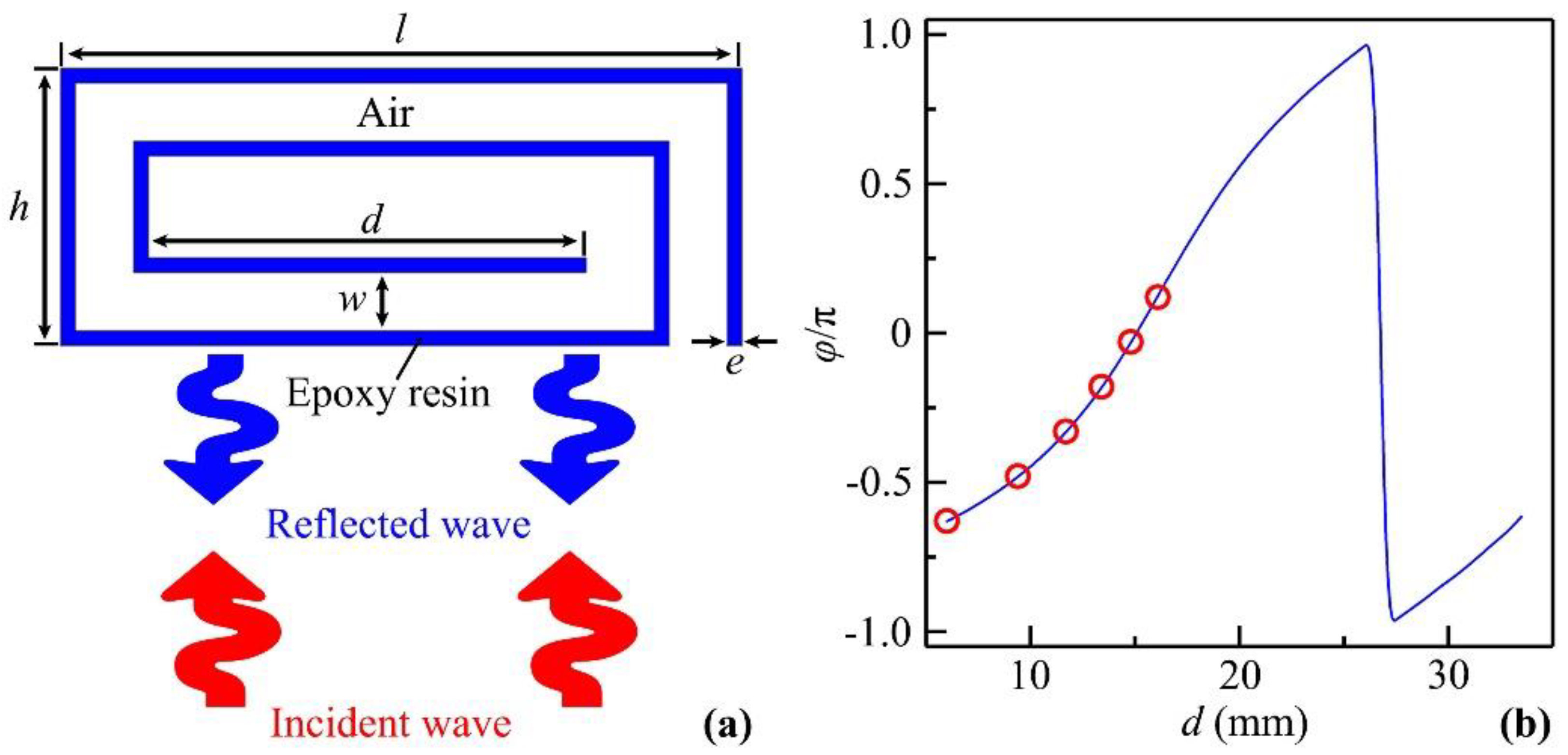
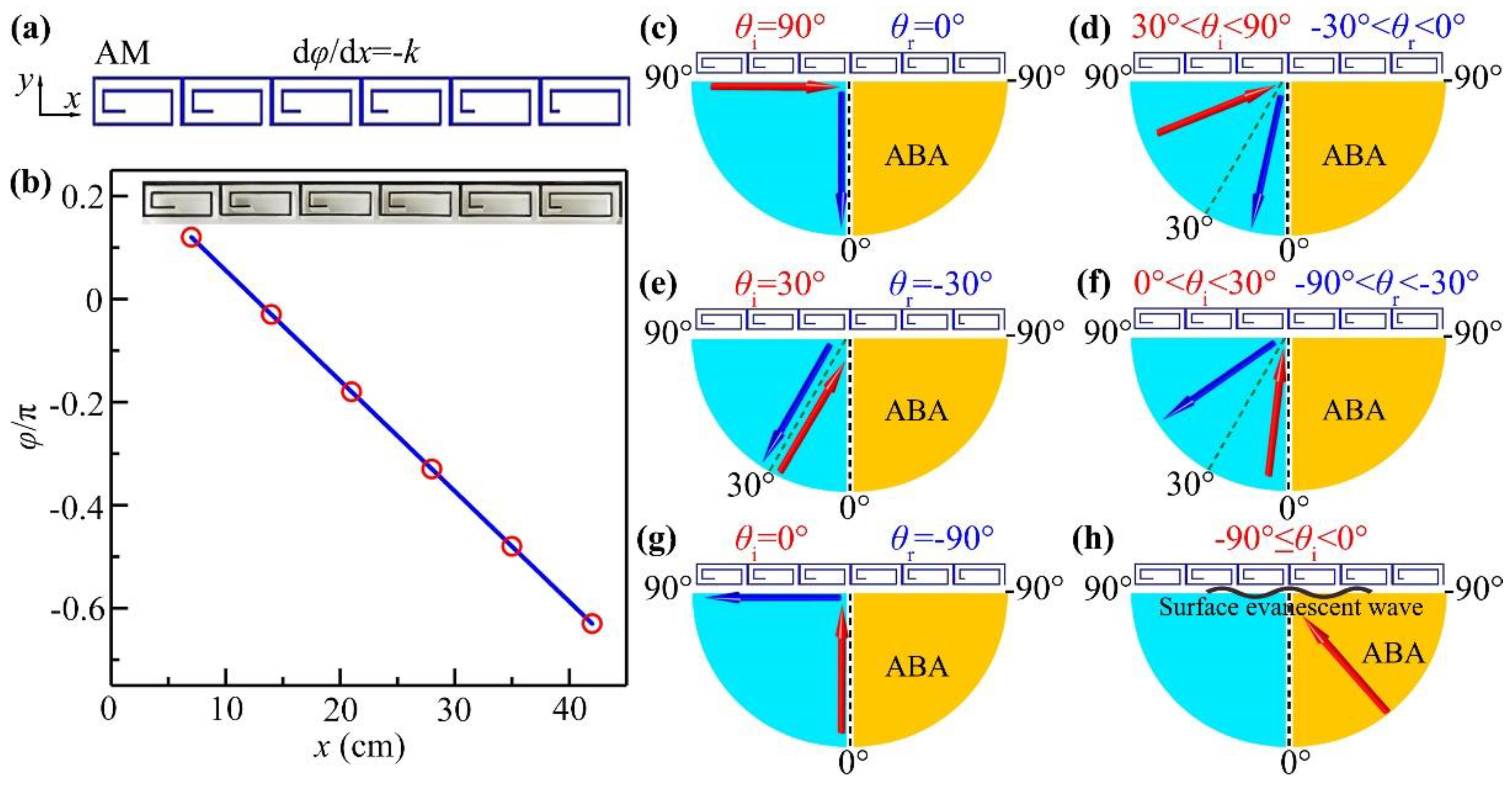

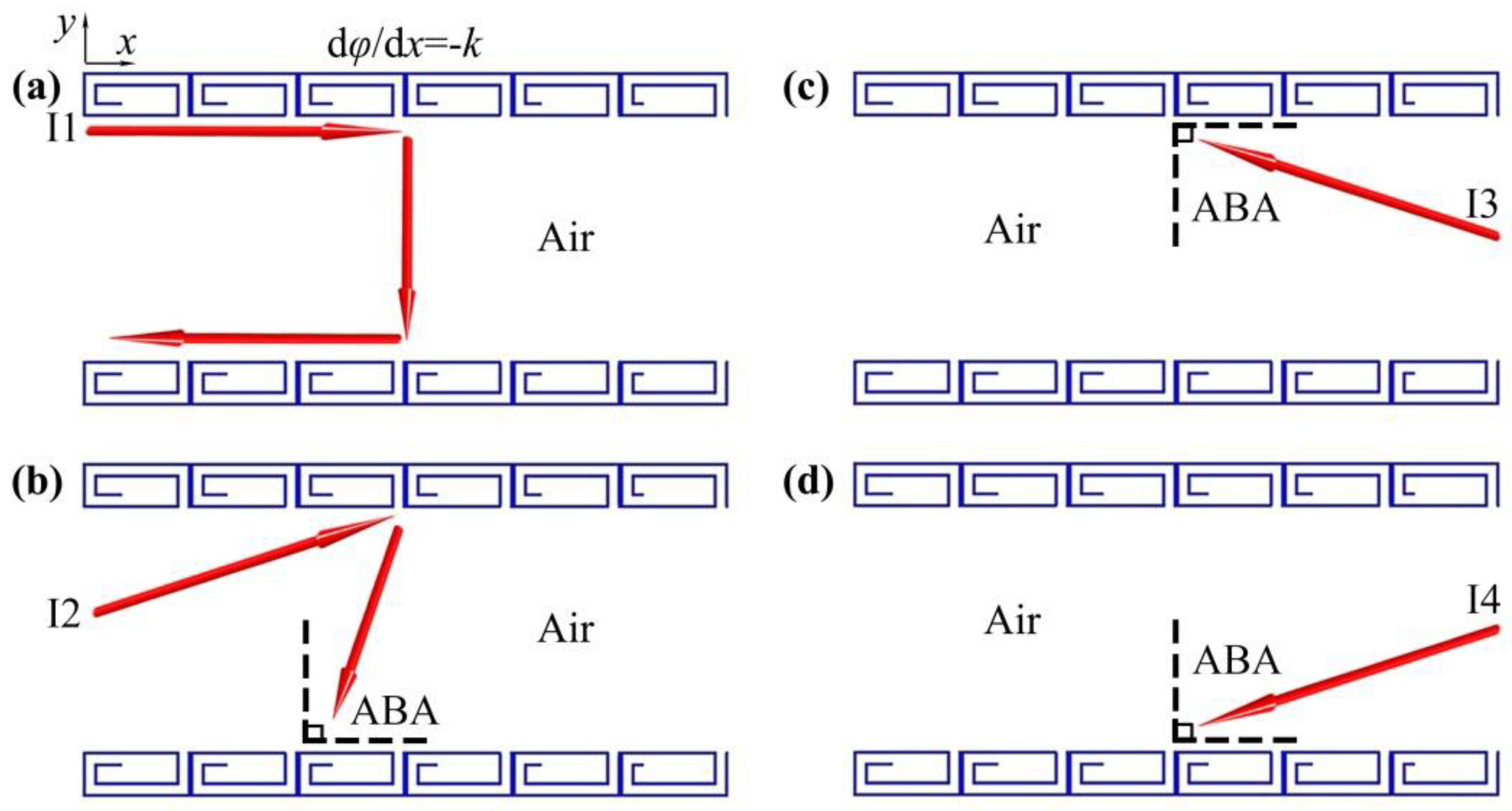
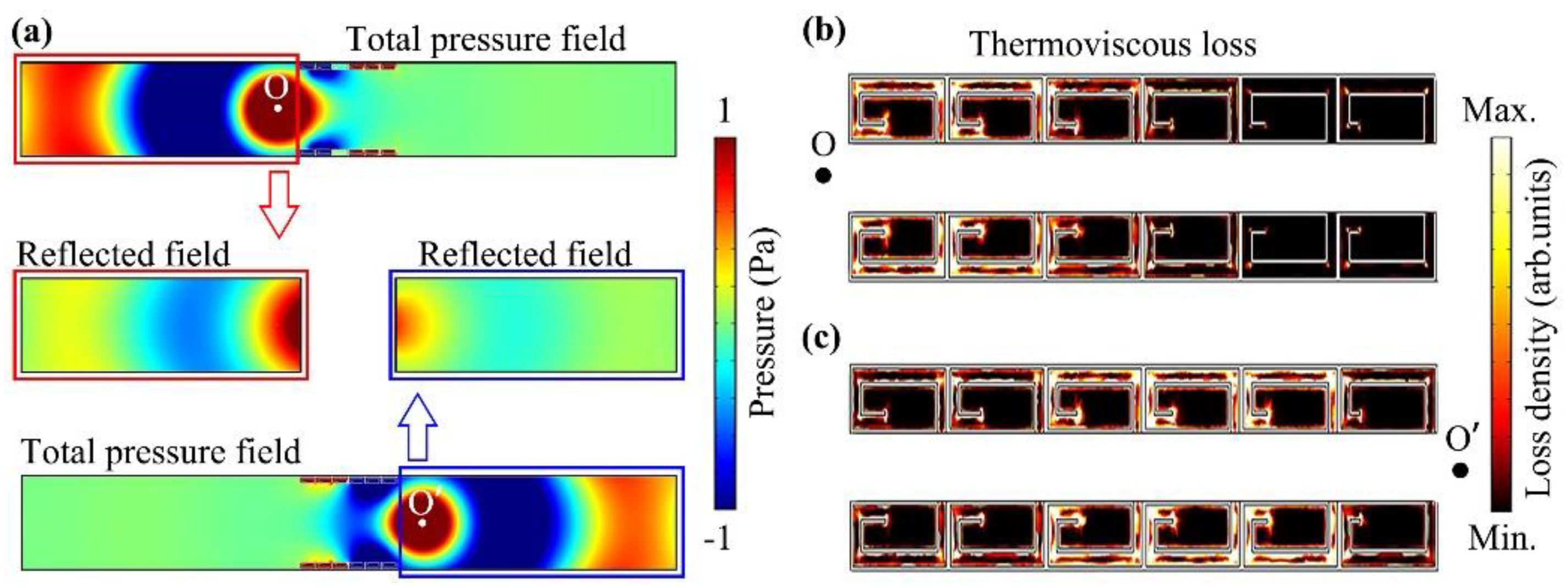
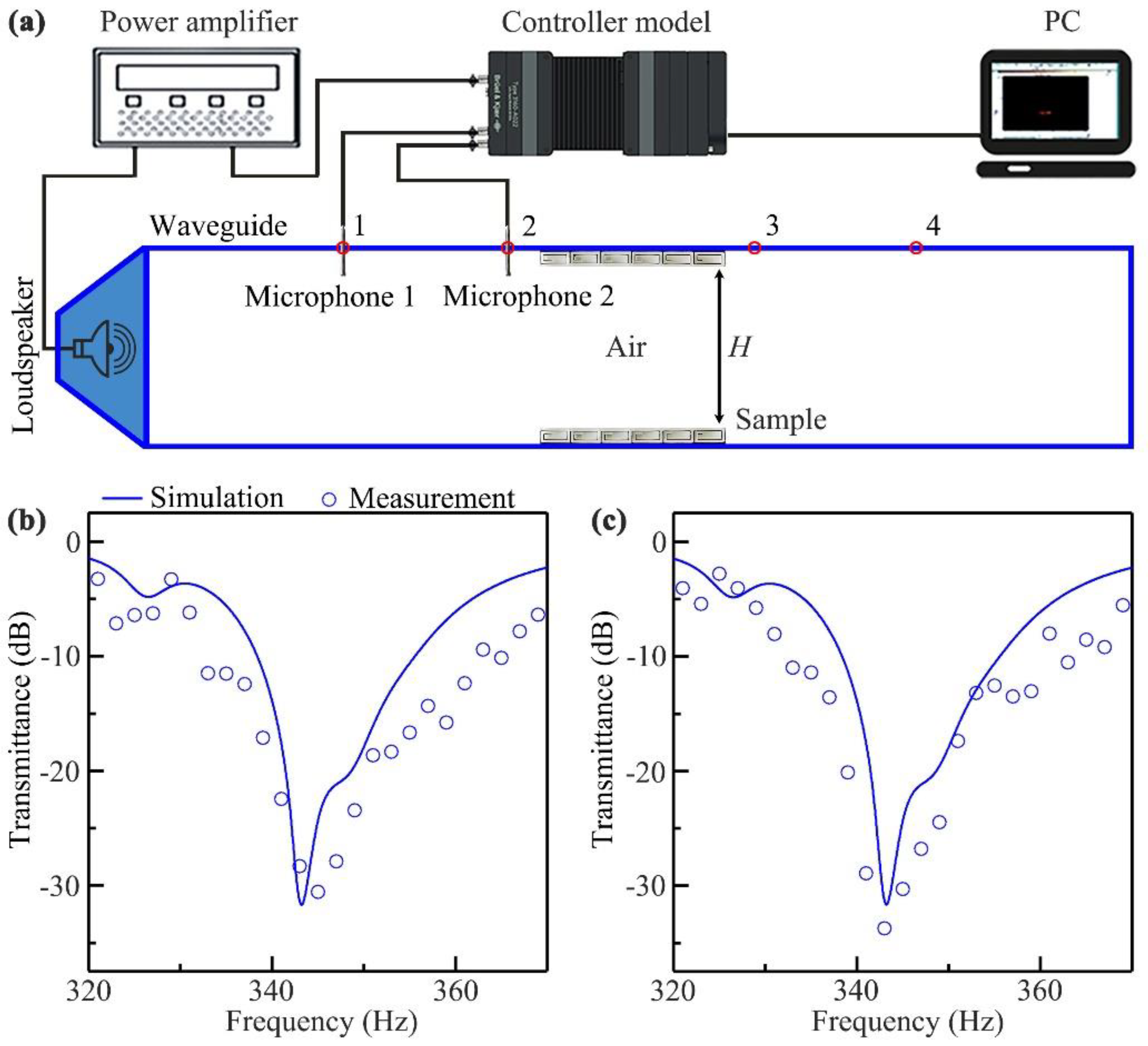

| Numerical Model | Setting |
|---|---|
| Region out of the unit cell | Module of Acoustic Pressure |
| Region in the unit cell | Module of Thermoviscous Acoustic-Solid Interaction |
| Surfaces of the unit cell | Thermoviscous acoustic boundary layers |
| Interfaces between regions in and out of unit cells | Acoustic-thermoviscous acoustic coupling boundary |
| Parameter | Epoxy Resin | Air |
|---|---|---|
| Density (ρ) | 1180 kg/m3 | |
| Longitudinal wave velocity (cl) | 2720 m/s | |
| Transversal wave velocity (ct) | 1460 m/s | / |
| Molar mass (M) | / | 28.97 × 10−3 kg/mol |
| Ratio of the molar heat capacities (γ) | / | 1.4 |
| Molar gas constant (R) | / | 8.31 J/(mol/K) |
| Air pressure (p0) | / | 101.325 kPa |
| Air temperature (T) | / | 293 K |
| Coefficient of dynamic viscosity (μ) | / | 1.56 × 10−5 Pa·s |
| Instrument | Type |
|---|---|
| Power amplifier | PA-50 |
| Controller model | Brüel & Kjær 3160-A-022 |
| Microphone | Brüel & Kjær type-4954 |
Publisher’s Note: MDPI stays neutral with regard to jurisdictional claims in published maps and institutional affiliations. |
© 2022 by the authors. Licensee MDPI, Basel, Switzerland. This article is an open access article distributed under the terms and conditions of the Creative Commons Attribution (CC BY) license (https://creativecommons.org/licenses/by/4.0/).
Share and Cite
Guan, Y.-J.; Xu, Y.-W.; Ge, Y.; Sun, H.-X.; Yuan, S.-Q.; Liu, X.-J. Low-Frequency Low-Reflection Bidirectional Sound Insulation Tunnel with Ultrathin Lossy Metasurfaces. Appl. Sci. 2022, 12, 3470. https://doi.org/10.3390/app12073470
Guan Y-J, Xu Y-W, Ge Y, Sun H-X, Yuan S-Q, Liu X-J. Low-Frequency Low-Reflection Bidirectional Sound Insulation Tunnel with Ultrathin Lossy Metasurfaces. Applied Sciences. 2022; 12(7):3470. https://doi.org/10.3390/app12073470
Chicago/Turabian StyleGuan, Yi-Jun, Yu-Wei Xu, Yong Ge, Hong-Xiang Sun, Shou-Qi Yuan, and Xiao-Jun Liu. 2022. "Low-Frequency Low-Reflection Bidirectional Sound Insulation Tunnel with Ultrathin Lossy Metasurfaces" Applied Sciences 12, no. 7: 3470. https://doi.org/10.3390/app12073470
APA StyleGuan, Y.-J., Xu, Y.-W., Ge, Y., Sun, H.-X., Yuan, S.-Q., & Liu, X.-J. (2022). Low-Frequency Low-Reflection Bidirectional Sound Insulation Tunnel with Ultrathin Lossy Metasurfaces. Applied Sciences, 12(7), 3470. https://doi.org/10.3390/app12073470







